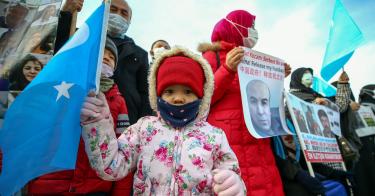With every new revelation, the situation in Xinjiang appears more dire. The Uyghur people are crying out for help. But will the world hear them?
What Beijing is doing to the Uyghurs is grave. Back in January, the U.S. government issued an official “determination” that genocide and crimes against humanity had occurred—and remain ongoing—in Xinjiang. Given this determination, U.S. lawmakers have no choice but to craft effective responses to end these abhorrent practices.
Here’s what we know about the situation in Xinjiang. Between 1.8 million and 3 million Uyghurs are currently held in “political reeducation facilities.” Inside these camps, Uyghurs are subject to more than just forced reeducation. They also face rape and other sexual violence and sometimes even death.
Other reports have revealed that the Chinese Communist Party (CCP) had an established goal of forcibly sterilizing 80-90% of Uyghur women of childbearing age in certain provinces. Through this policy, Beijing aims to ensure a significantly smaller, if not entirely nonexistent, next generation of Uyghurs.
>>> China’s Horrifying War on Uighur Women
And it’s a safe bet that the CCP will make the lives of those who manage to survive a living hell. The CCP is already busy subjugating Uyghurs by means of forced labor. Investigations using detailed satellite imagery confirm that 170 of the 260 known political reeducation camps have shared facilities with factories, where the detainees are no doubt forced to work.
The CCP has also rolled out labor-transfer schemes whereby the party transfers Uyghurs to other worksites within or outside of Xinjiang. Adrian Zenz, a well-known China scholar at the Victims of Communism Memorial Foundation, estimates that, in 2018 alone, at least 570,000 Uyghurs were mobilized to pick cotton.
The extent of these dirty practices has made it more and more difficult for legitimate industries to operate with clean hands. The party’s exploitative practices, shrouded in secrecy, make it all but impossible for firms to audit their supply chains in Xinjiang. As such, the U.S. government has stepped up its response to reports of forced labor in the region.
Section 307 of the Tariff Act of 1930, prohibits goods produced with forced labor from entering U.S. markets. To enforce this, the U.S. Customs and Border Patrol has applied several tools at its disposal, the two most useful being Withhold Release Orders (WROs) and rebuttable presumptions.
WROs require the agency to investigate claims that goods awaiting importation were produced with forced labor. Rebuttable presumptions assume that, if a good originates from a discrete geographic location, like Xinjiang, it is assumed to be produced with forced labor unless proven otherwise. Both of these tools enable the agency to intercept suspect goods at the border.
The U.S. government has already put in place industry-specific WROs for cotton and tomatoes originating in Xinjiang, but Congress is currently mulling over approving broader powers that would create a region-wide rebuttable presumption, covering all goods originating there.
That’s the way to go, but Washington should use a data-driven approach to combat forced labor in Xinjiang.
>>> Strengthening the U.S. Response to Forced Labor in Xinjiang
First, it should expand the existing cotton and tomato WROs to a region-wide level for a two-year period. If an overwhelming percentage of goods apprehended by CBP under the expanded WRO are found to have been produced with forced labor, then the U.S. should institute a region-wide rebuttable presumption. Such an approach leaves no stone unturned and gives policymakers greater insight into the extent to which Xinjiang markets are tainted by forced labor.
No Uyghur—no person, for that matter—should be subjected to forced labor. As the U.S. crafts its response to one of the worst atrocities of the 21st century, it has an opportunity to sharpen tools to combat the global scourge of forced labor.
This piece originally appeared in The Washington Times



